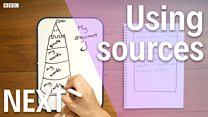Unit 5: Go The Distance: Finding and using source material
Select a unit
- 1 Go The Distance: Choosing distance learning
- 2 Go The Distance: Academic reading
- 3 Go The Distance: Academic talk
- 4 Go The Distance: Academic writing
- 5 Go The Distance: Finding and using source material
- 6 Go The Distance: Going the distance
- 7 Go The Distance: Critical thinking
- 8 Go The Distance: Social learning
- 9 Go The Distance: Projects
- 10 Go The Distance: Succeeding in exams
Session 2
Academic Insights 5 – Finding and using sources
Welcome back to Academic Insights – the place where we meet distance learning tutors and get their top tips for successful study. This time we meet tutor Julian and take a look at a challenging area of academic study: finding and using source material to support your arguments.
Activity 1
How to find good academic sources
Julian Cooper is a distance learning tutor. He helps students develop their skills, showing them how to support their thoughts and opinions by finding good source material - and using it well. Scroll down to watch the video and hear Julian's tips. But first, take a look at the definitions of some key words from the video in the Session Vocabulary box.

#9 things you really need to know
How do you find good source material? Julian answers your top questions in 3 minutes.
To do
Scroll down to watch the video and find out:
- Why you should include references in your work
- How to choose good source material
- What's the better source: an academic journal or a magazine?
- Which sources to avoid
- And more!
Watch the video

Julian
It's really attractive to be able to write what you think about your own subject. But actually, it's also really important to justify and show that you have done some additional reading and researching, and you're gaining additional insights. So that means that you're not only writing what your views are: you're actually using others' - well-known authors' perhaps - to support, justify, or maybe add a different context to the view.
When students are looking for good source material, the first rule is to make sure that it fits the subject area. And then you're looking to make it fit with the question, to make it pertinent to the question, and to support and justify some of your own arguments and discussions.
Well, you can look in books; you can look in journals. You can look in - you can look in associated material. It really depends on the context of the subject you're writing about. But it may also be good to take some more current examples - maybe from a magazine - that look at the subject area from a different and lighter context.
Sometimes students get in touch: they're struggling to find material. It just doesn't appear to be available. Usually if you go to your university library, you go online, and many university libraries have chat rooms now, and they're often available 24 hours a day; and they will really help you find, if not the actual source, something that is quite similar.
Where non-native speaking students actually find a problem and it's difficult to understand a paper, really the best tip is to go to the introduction. Go to a summary; go to a précis, and look at what the paper is trying to say, and then you can actually unpick it piece by piece. And it may be that actually the paper really is too complex, because if it's complex to a native speaker or a non-native speaker, generally it's something perhaps you should be avoiding.
Students should really try to avoid promo material - promotional material - that's dressed up as theory. And in particular, in the technology area, there are lots of new concepts and theories coming through all the time. And particular organizations actually try to launch new ideas, new concepts and to get them accepted as - if you like - solid theory, when in effect they're really promoting their own new technology.
When students choose poor material to support their arguments then it's usually quite clear: it doesn't add value to it; it doesn't add depth to it; it doesn't add breadth to it. It really just stands on its own. What it should be doing is actually adding value almost seamlessly to the paper.
The extra points is where they've added: significant justification, new ideas, being critical in a positive way to the subject area, and really showing that they've understood that and dug deeply into the underlying concepts.
Go the distance.
Julian's tips
Let's review the #9 things we've learned about finding good sources for use in your academic assignments.
- It's great to write what you think about a subject – but including references shows your readers that you have done additional reading and research.
- Good source material needs to fit the subject area, so that you can use it to justify and support the arguments you are exploring in your assignment.
- Books and journals are good academic material, but don't forget sources like magazines – these may give you a more current, lighter view on a topic.
- University libraries and websites are good places to look if you're struggling to find sources – you'll be able to get help there.
- Make use of introductions and summaries to help you understand what an academic source is saying.
- If you are finding it difficult to understand a source, it may actually be too complex – don't struggle too much and try to find another source.
- Avoid promotional material! This may look like academic theory, but it may actually be promoting a product or service.
- Use sources that make your work better – academic sources should add depth and breadth to your arguments.
- Good use of academic sources will upgrade your assignments – showing that you understand your subject area and can write critically.
Session Vocabulary
Find out more about distance learning – visit our partner,The OU
____________________
Want to know how to find good sources for your academic assignments? Of course you do! But first, to make sure you don't miss any of Julian's tips, here are some useful words and phrases:
pertinent
relevant to a particular question or topiclighter
(here) less academic or formaldressed up
made to look like something else


